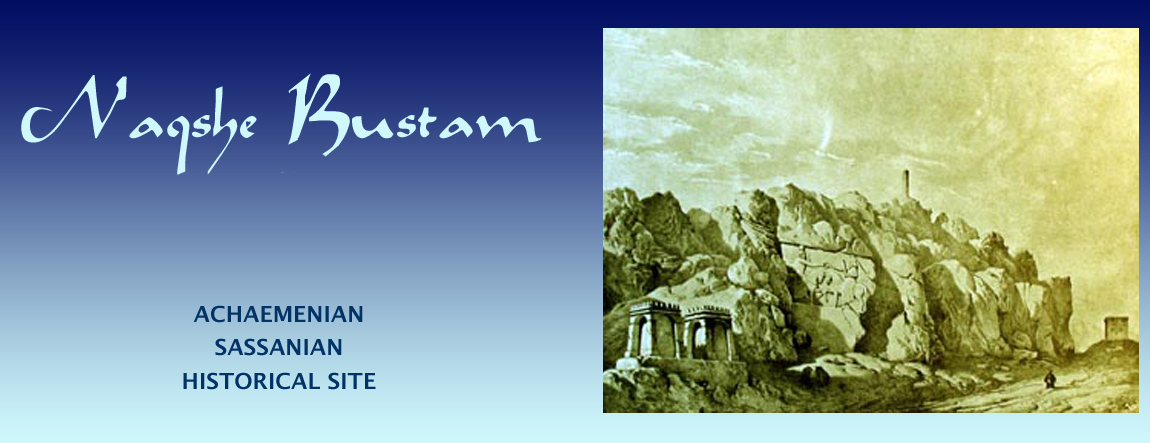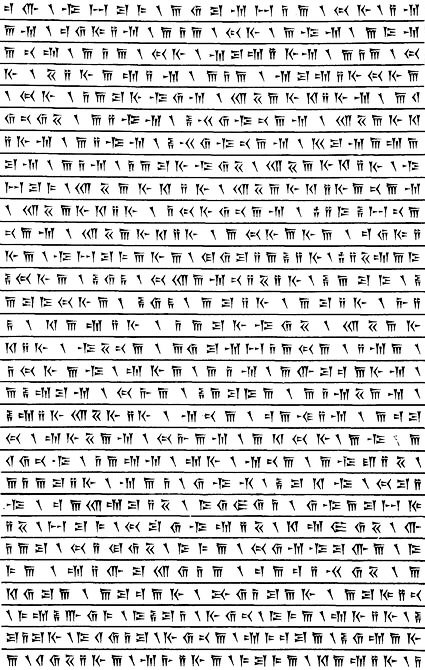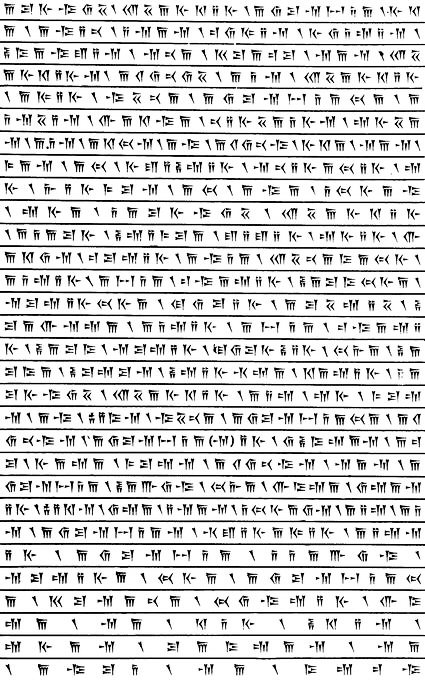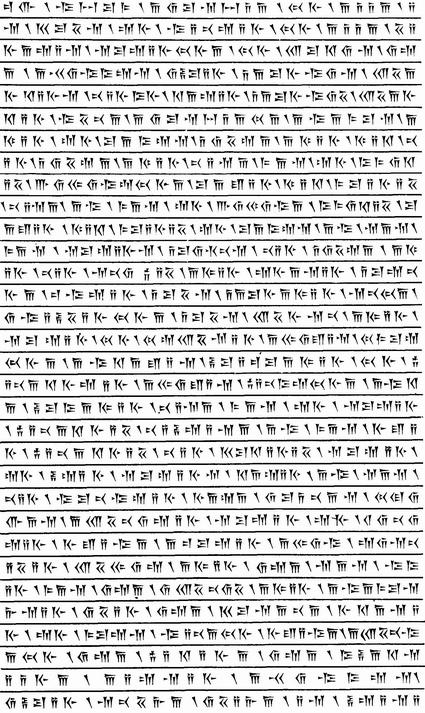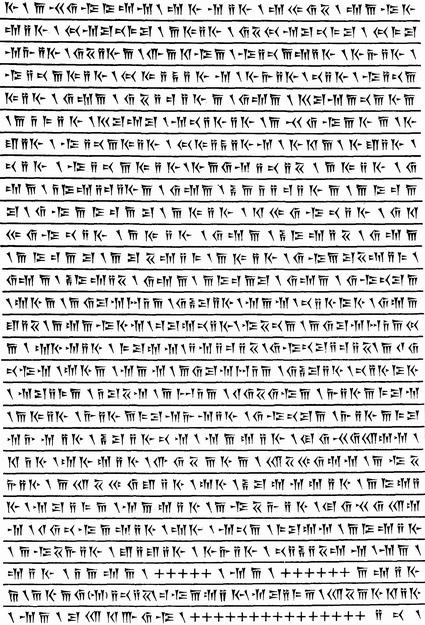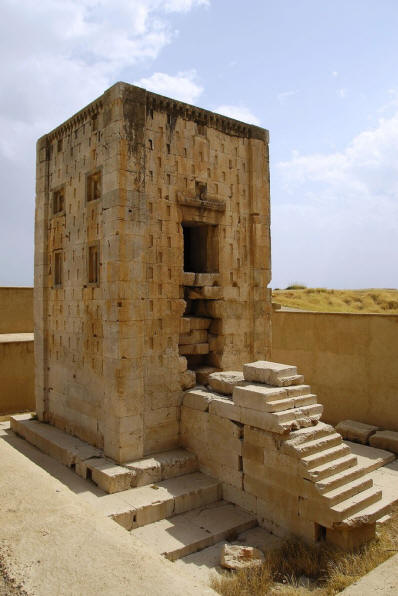
Contents
|
Page 2
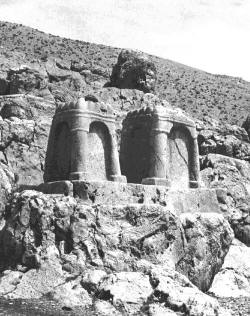
|
| Open Air Fire Platform 522-486 BCE |
Achaemenian Fire Altars
At the western end of the site are two open-air fire altars. Early Zoroastrian worship was conducted in the open and there were no temples. This practice is discussed further in our page on worship.
Achaemenian Tombs
Another local name for the site is Salib, an Arabic word that may be derived from the Persian word for a cross, chalipa, the shape of the facade of the tombs. Yet another name for the site is Persian Crosses. The tombs are all looted and desecrated following Alexander of Macedonia's invasion and defeat of the Achaemenians.
The tombs are burial chambers carved into the side of the hill rock. A sarcophagus was placed within the burial chamber. It is not known if the body was placed directly in the sarcophagus or if the bones from a dakhma (a tower of silence) were placed in the containers which could have served as ossuaries. Both practices would have been consistent with Zoroastrian burial practices since the body is not in contact with the soil. (Even in a dakhma, the body comes in contact with stone.)
The style of the horizontal lintel above each tomb's entrance resembles the style used at Persepolis.
Only one of the tombs can be positively identified as the tomb of Darius the Great, since the facade contains inscribed text. However, the style of all the tombs is distinctly Achaemenian and a deductive process allows a reasonable allocation of each of the tombs to a particular Achaemenian king.
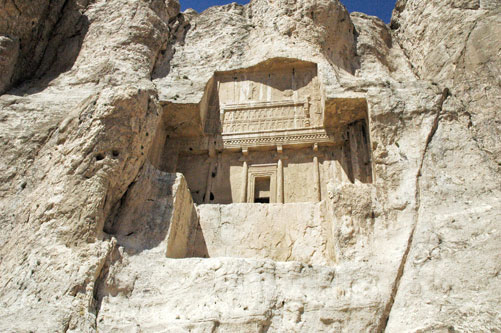 |
| Tomb #3 Artaxerxes? |
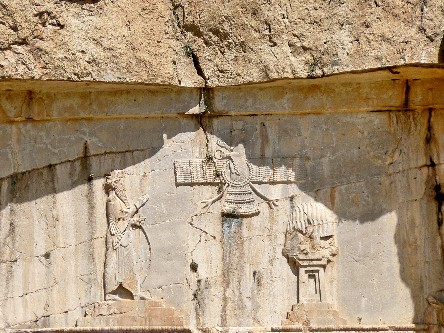 |
| Tomb #2 Xerxes?. The king praying with his farohar above |
|
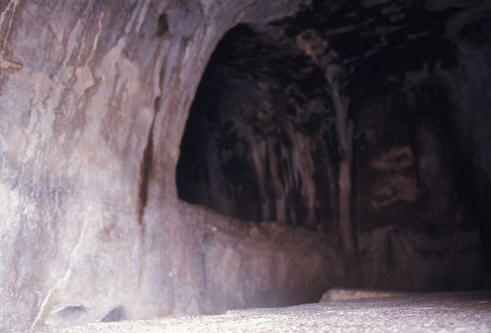 |
Tomb #2 Interior Showing burial chambers
The soot on the walls is from fires |
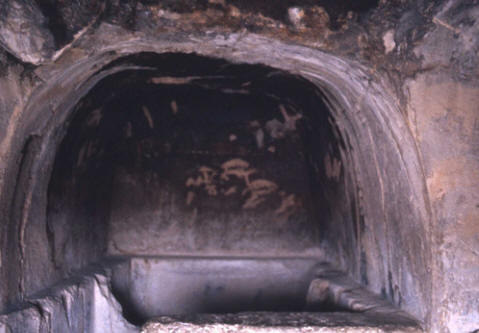 |
Tomb #2 Interior Showing twin burial chambers
Wall between the two chambers has been broken down |
|
Inscriptions on Darius' Tomb
The engraved panel that forms the top arm of the cross shaped facade of the tomb of Darius I, the Great, contains an image of Darius standing in prayer before a fire altar. The platform on which he is standing is supported by twenty-eight men from the different the nations in Darius' Persian empire.
The panel also contains two sets of cuneiform inscriptions in Old Persian. The inscription in the top-left corner, is known as DNa. The central part of the cross contains another inscription known as DNb.
 |
| Top panel of Darius' Tomb (#1) |
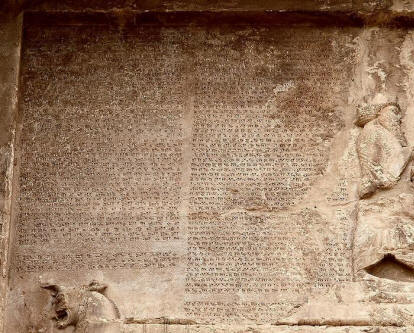 |
| Inscription DNa in the top left hand corner |
|
| Inscription DNa | Text | Translation |
|---|
|
|
1 baga1 vazraka2 Auramazda3, hya4 im-
2 am5 bumam1 ada2, hya3 avam4 asm-
3 anam5 ada1, hya2 martiyam3 ada4, h-
4 ya5 shiyatim1 ada2 martiyahya3,
5 hya1 Darayavaum2 khshayathiyam3 ak-
6 unaush4, aivam1 paruvnam2 khshayath-
7 iyam3, aivam1 paruvnam2 framata-
8 ram3. adam1 Darayavaush2 khshayathiya3 va-
9 zraka4, khshayathiya1 khshayathiyanam2,
10 khshayathiya1 dahyunam2 vispazana-
11 nam3, khshayathiya1 ahyaya2 bumi-
12 ya3 vazrakaya1 duraiapiy2 Vishtas-
13 pahya3 pucha1, Haxamanishiya2, Parsa3 P-
14 arsahya4 pucha1, Ariya2, Ariya3 ci-
15 cha4. thatiy1 Darayavaush2 khshaya-
16 thiya3, vashna1 Auramazdaha2 ima-
17 dahyava3 tya1 adam2 agarbayam3
18 apataram1 haca2 Parsa3 adamsham4
19 patiyakhshayaiy1 mana2 bajim3 abara-
20 ha4 tvasham1 hacama2 athahya3 ava4 a-
21 kunava5 datam1 tya2 mana3 avadish4
22 adaraiya1 Mada2 Uvja3 Parthava4 Harai-
23 va5 Baxtrish1 Suguda2 Uvarazm-
24 ish3 Zraka1 Harauvatish2 Thatagush3 Ga-
25 dara4 Hidush1 Saka2 Haumavarga3 Sa-
26 ka4 Tigrakhauda1 Babirush2 A-
27 thura3 Arabaya1 Mudraya2 Armina3
28 Katpatuka1 Sparda2 Yauna3 Saka4 tyaiy5 pa-
29 radraya6 Skudra1 Yauna3 takabara2 Putay-
30 a4 Kushiya1 Maciya2 Karka3. thatiy4 D-
31 arayavaush5 khshayathiya1 Auramazda2 yath-
32 a avaina1 imam2 bumim3 yaudatim4
33 pasavadim1 mana2 frabara3 mam4 khsha-
34 yathiyam5 akunaush1 adam2 khshayathiya3.
35 amiy1 vashna2 Auramazdaha3 a-
36 damshim4 gathava1 niyashadayam2 tyasha-
37 m3 adam1 athaham2 ava3 akunava4 yatha5 mam6
38 kama1 aha2 yadipatiy3 maniyahaiy4 t-
39 ya5 ciyakaram1 aha2 ava3 dahyava
40 tya1 Darayavaush2 khshayathiya3
41 adaraya1 patikara2 didiy3 tyaiy4 g-
42 athun5 baratiy1 avada2 khshnasahy3
43 adataiy1 azda2 bavatiy3 Parsahya4
44 martiyahya1 duraiy2 arshtish3 pa-
45 ragmata4 adataiy1 azda2 bavati-
46 y3 Parsa1 martiya2 durayapiy3 haca4 Pa
47 rsa5 partaram1 patiyajata2 thatiy3 Da-
48 rayavaush4 khshayathiya1 aita2 tya3 karta-
49 m4 ava1 visam2 vashna3 Auramazdaha4 ak-
50 unavam5 Auramazda(ma)iy1 upastam2 aba-
51 ra3 yata1 kartam2 akunavam3 mam4 A-
52 uramazda5 patuv1 haca2 gasta3 utama-
53 iy4 vitham1 uta2 imam3 dahyaum4 aita5 ada-
54 m6 Auramazdam1 jadiyamiy2 aitama-
55 iy3 Auramazda1 dadatuv2
56 martiya1 hya2 Auramazdah-
57 a3 framana1 hauvtaiy2 gas-
58 ta3 ma1 thadaya2 pathim-
59 tyam3 rastam1 ma2
60 avarada1 ma2 stabava3
|
Great2 God1 Ahuramazda3, who4
created2 this5 earth1, who3 created1 that4 sky5,
who2 created4 humankind3, who5
created2 happiness1 for human-beings3,
who1 granted4 Darius2 be4 king3,
one1 king3 of many2,
one1 lord3s of many2.
I am1 Darius2 Great4 King3,
King1 of Kings2,
King1 of countries2 diverse3,
King2 of these2 lands3
great1 and distant2, son1 of Hystaspes1,
an Achaemenian2, a Persian3, son1 of a Persian4,
an Aryan1, having Aryan2 lineage4.
Declared1 Darius1 King3:
By the grace1 of Ahuramazda2
these countries3 that1 I2 occupied3
outside1 of2 Persia3; I ruled over them4;
they bore tribute to me.
What was said to them by me,
that they did; my law - that held them
firm; Media2, Elam3, Parthia3, Aria4,
Bactria1, Sogdiana2, Chorasmia3,
Drangiana,1 Arachosia2, Sattagydia3, Gandara4,
Sind1, Haumavarga3 Saka2, Saka4
Tigrakhauda1, Babylonia2, Assyria3,
Arabia1, Egypt2, Armenia3, Cappadocia1,
Sardis2, Ionia3, Saka4 who are5 across the sea/river6,
Skudra1, petasos-wearing2 Ionians3, Libyans4,
Ethiopians1, people of Maka3, Carians4. Declared4 Darius5
the King1: When3 Ahuramazda2
beheld1 the2 earth3 in turmoil4,
thereupon1 upon me2 was bestowed3 my4 kingship5;
I2 became1 king3.
By1 the grace2 of Ahuramazda3 I4
restored2 the throne1; what3
I1 decreed2, that3 they obeyed4, as5 my6
desire1 was2. Now3 if you wonder4 this5:
How many1 are2 those3 countries4
which1 King3 Darius2
held1, look at3 the sculptures2 (of those) who4
bear1 the throne5, then2 you will know3,
Also, to you1 it will become3 known2
the spear3 of a Persian4 man1 has gone forth4 far2;
Further, to you1 it will become3 known2
a Persian1 man2 has very far3 from4 Persia5.
Has fought2 in war1. Declared3 Darius4
King1: This2 which3 has been done4,
all2 that1 by the will3 of Ahuramazda4
I did5. Ahuramazda1 bore3 me aid2,
until1 I accomplished3 the work2. May Ahuramazda5
protect1 me4 from2 harm3, and my4
royal house1, and2 this3 land4 and5 I6
pray2 of Ahuramazda1, this may3
Ahuramazda3 give2
O man1, that which2 Ahuramazda3
commands1, let this not
seem repugnant to you;
do not2 leave the right2 path3;
do not2 rise in rebellion!
Translation: K. E. Eduljee
|
| Inscription DNb | Text | Translation |
|---|
|
|
1 baga1 vazraka2 Auramazda3, hya4 adada5 i-
2 ma6 frasham1 tya2 vainataiy3, hya4 adada5 shi-
3 yatim6 martiyahya1, hya2 khrathum3 ut-
4 a4 aruvastam1 upariy2 Darayavaum3 khsha-
5 yathiyam4 niyasaya1. thatiy2 Darayavaush3 khshayathiya4:
6 vashna1 Auramazdaha2, ava-karam3 a-
7 miy4 tya1 rastam2 daushta3 amiy4, mitha5 na-
8 iy6 daushta1 amiy2. Naima3 kama4 tya5
skauthish6
9 tunuvatahya1 radiy2 mitha3 kariyaish4
10 naima1 ava2 kama3 tya4 tunuva5 skauthaish6
11 radiy1 mitha2 kariyaish3. tya4 rastam5
ava6 mam7
12 kama1. martiyam2 draujanam3 naiy4 daushta5 am-
13 iy1. naiy2 manauvish3 amiy4. tyamaiy5 dartana-
14 ya6 bavatiy1 darsham2 darayamiy3 manaha4
15 uvaipashiyahya1 darsham2 khshayamna3 amiy4.
16 martiya hya hatakhshataiy anudim hakarta
17 hya avathadim paribaramiy hya v
18 inaithayatiy anudim vinastahya avath
19 a parsamiy naima kama tya martiya
20 vinathayais naipatima ava kama yadi
21 y vinathayaish naiy frathiyaish martiya
22 tya patiy martiyam thatiy ava mam
23 naiy varnavataiy yata uradanam hadu
24 gam akhshnautiy martiya tya kunau
25 tiy yadiva abaratiy anuv tauman
26 ishaiy khshnuta amiy uta mam vas
27 iy kama uta ukhshnaush amiy avakaram
28 camaiy ushiy uta framana yathamai
29 y tya kartam vainahy yadiva akhshnav
30 ahy uta vithiya uta spathma
31 idaya aitamaiy aruvastam
32 upariy manashca ushica ima patimai
33 y aruvastam tyamaiy tanush tavaya
34 tiy hamaranakara amiy ushhamaranakara hakara
35 mciy ushiya gathava vainataiy yaciy
36 vainamiy hamichiyam yaciy naiy vaina
37 miy uta ushibiya uta framanaya
38 adakaiy fratara maniyaiy aruvaya ya
39 diy vainamiy hamichiyam yatha yadiy
40 naiy vainamiy yaumainish amiy u
41 ta dastaibiya uta padaibiya asaba
42 ra uvasabara amiy thanuvaniya utha
43 nuvaniya amiy uta pastish uta
44 asabara arshtika amiy uvarshtika
45 uta pastish uta asabara uta uvnara
46 tya Auramazda upariy mam niyasaya uta
47 dish atavayam bartanaiy vashna Auramazdah
48 a tyamaiy kartam imaibish uvnaraibish aku
49 navam tya mam Auramazda upariy niyasaya
50 marika darsham azda kushuva ciyakaram
51 amiy ciyakaramcamaiy uvnara ciyakara
52 mcamaiy pariyanam mataiy duruxtam
53 thadaya tyataiy gaushaya khshnnutam avash
54 ciy akhshnudiy tya partamtaiy asti
55 y marika mataiy avashciy duruxta
56 m kunavataiy tya mana kartam astiy
57 avashciy didiy yaciy nipishtam ma
58 taiy data +++++ ma ++++++atiy
59 a ayau(ma)inish bavatiy marika khshayathiya
60 ma raxthatuv +++++++++++++++ina
|
Great2 God1 Ahuramazda3, who4 created5
this6 excellence1 which2 is seen3, who4 created5
happiness6 for human beings1, who2 wisdom3 and4
activity1 upon2 Darius3 (the) King4
bestowed1. Declares2 Darius3
the King4:
By the grace of1 Ahuramazda2, of such3 am I4,
that1 to right2 a friend3 I am4, to wrong5
a friend1 I am2 not6. Nor is it3 my desire4 that5 the weak6
be wronged3 & 4 by2 the powerful1,
nor is it1 my desire3, that4 the powerful5
be wronged2 & 3 by1 the weak6. What4 is right5
that is6 my7
desire1. To men2 who follow the Lie3, I am1 not4 a
friend5. I am4 not2 thoughtless3. What things
develop in my anger, I hold3 firm2 under control by
my thinking4 power. I am4 firm2 control3.
16-20. The man who cooperates, him according to his cooperative action, him thus do I reward. Who does harm, him according to the damage thus I punish. It is not my desire that a man should do harm; nor indeed is that my desire, if he should do harm, he should not be punished.
21-24. What a man says against a man, that does not convince me, until he satisfies the Ordinance of Good Regulations.
24-27. What a man does or performs (for me) according to his (natural) powers, (therewith) I am satisfied, and my pleasure is abundant, and I am well satisfied.
27-31. Of such a sort is my understanding and my command: when what has been done by me you shall see or hear of, both in the palace and in the war camp, this is my activity over and above my thinking power and my understanding.
31-40. This indeed is my activity: inasmuch as my body has the strength, as battle-fighter I am a good battle fighter. Once let there be seen with understanding in the place (of battle), what I see (to be) rebellious, what I see (to be) not (rebellious); both with understanding and with command then am I first to think with action, when I see a rebel as well as when I see a not-(rebel).
40-45. Trained am I both with hands and with feet. As a horseman I am a good horseman. As a bowman I am a good bowman both afoot and on horseback. As a spearman I am a good spear-man both afoot and on horseback.
45-49. And the (physical) skills which Ahuramazda has bestowed upon me and I have had the strength to use them -- by the grace of Ahuramazda what has been done by me, I have done with these skills which Ahuramazda has bestowed upon me.
50-55. O menial, vigorously make you known of what sort I am, and of what sort my skills, and of what sort my superiority. Let not that seem false to you, which has been heard by thy ears. That do you hear, which is communicated to you.
55-60. O menial, let that not be made (to seem) false to you, which has been done by me. That do you behold, which [has been inscribed]. Let not the laws [be disobeyed] by you. Let not [anyone] be untrained [in obedience]. [O menial], let not the king (feel himself obliged to) inflict punishment (?) [for wrong-doing (?) on the dwellers (in the land) (?)].
|
Sassanian Reliefs
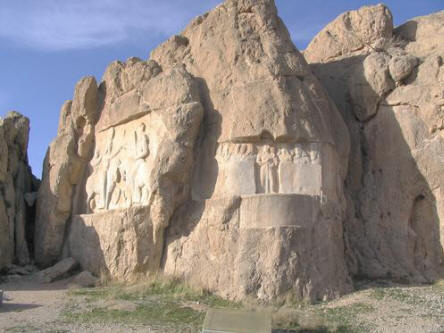 |
Left relief: Investiture of Ardeshir I (224/6-241 CE)
Right relief: Bahram II (276-293 CE) audience
The Bahram relief was superimposed over an earlier Elamite relief |
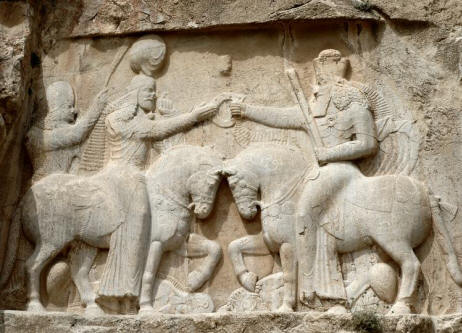 |
Investiture of Ardeshir I (224/6-241 CE), founder of the Sassanian dynasty
Ardeshir receives the ring of kingship from an individual carrying a barsom
- likely a priest (magus) and family member. |
|
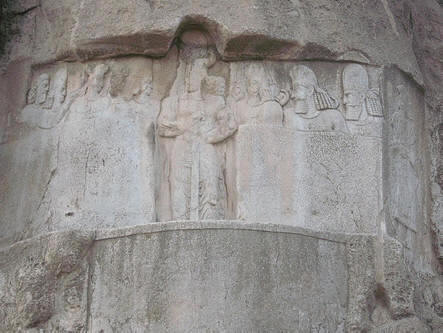 |
Bahram II (276-293 CE) audience
The panel to the extreme right is the remnant of the Elamite carving
that was carved over by the Bahram relief |
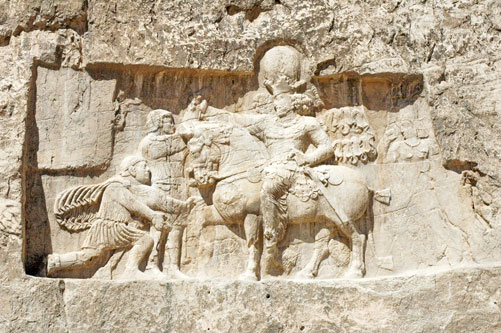 |
Triumph of Shapur I (241-272 CE) over the Romans.
Emperor Valerian is standing while Philip is kneeling |
|
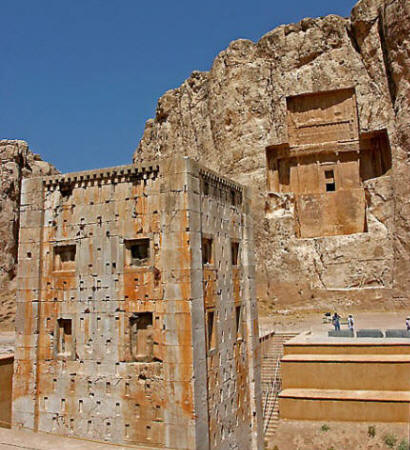 |
The Kaba-e Zarthosht with a tomb at Naqsh-e Rustam in the background.
A Sassanian stone relief can be seen faintly just below the tomb |
Kaba-e Zarthosht
Kaba-e Zarthosht is translated as the Cube or Enclosure of Zarathustra.
The building is square at its base, each side measuring 7.25 m and tapers slightly towards the top. It is 12.5 m. high. Each side of the building has slightly recessed false windows made from black limestone.
The Kaba-e Zarthosht at Naqsh-e Rustam is a copy of a similar building at Pasargadae, the capital of Cyrus the Great and the location of his mausoleum. The building at Naqsh-e Rustam was built by the Achaemenians sometime between 521 and 404 BCE. The building in Pasargadae is known locally as Zendan-e Suleiman / Eskandar ( the prison of Solomon / Alexander). Thought to be the tomb of Kabujiya / Cambyses II, the building at Pasargadae is badly damaged. Only one wall stands propped up by scaffolding.
The two buildings are remarkably alike in appearance, though different in the construction methods employed. Unlike its sister building in Pasargadae, Kaba-e Zarthosht's limestone blocks are held in place by iron cramps and not by mortar.
The functions of the two buildings are debated. At one time, the Kaba-e Zarthosht was thought to house a continuously burning fire and therefore, the precursor of subsequent fire temples. However, the lack of visible ventilation to support a fire, and the lack of windows has led some to believe that the building could not have housed a continuously burning fire.
Richard Frye author of The History of Ancient Iran, felt that both the Kaba and its sister building in Pasargadae were housed royal paraphernalia. Other historians feel they were royal Achaemenian tombs. Both buildings are said by some authors to more closer fit Arrian (6.29) and Strabo's (15.3.7) descriptions of the tomb of Cyrus the Great, than does the building in Pasargadae presently identified as Cyrus' mausoleum. However, it is possible that Arrian and Strabo incorrectly attributed the sister building at Pasargadae at Cyrus' tomb from amongst the several buildings there. Another interesting theory put forward by Iranian archaeologist Reza Moradi Ghiasabadi in 2005 was that the Kaba was used as an astronomical observatory and calendar. He states that, "At the end of Shahrivar (the sixth month of the Iranian calendar, August 23-September 22) we can determine exactly the day of the month by the light shed by the sun on Zoroaster's Kaba." We do not know if the building at Pasargadae has the same orientation - one that would need to be precisely the same as the Kaba in order for it to be used as a calendar.
The wall surrounding the Kaba was constructed during the Sassanian era.
The integrity of the Kaba is being compromised by a railroad under construction 350 metres from the monument. Besides, the railroad's five-metre high embankment is an eyesore.
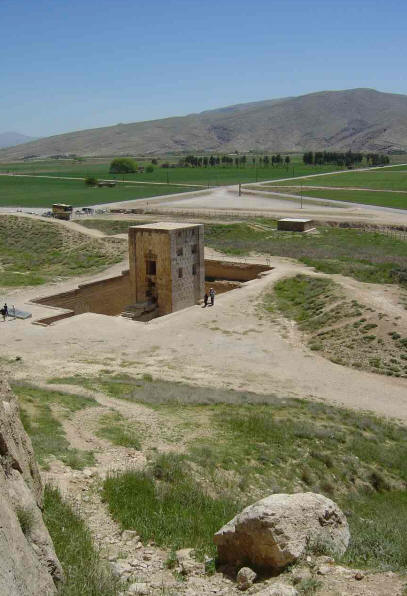 |
| View of the Kaba and valley plain behind |
|
Image Galleries: Oriental Institute, University of Chicago - CAIS - Presttun.org 1 - Presttun.org 2 - Flickr (Rob & Ale)
» Page 1
|
